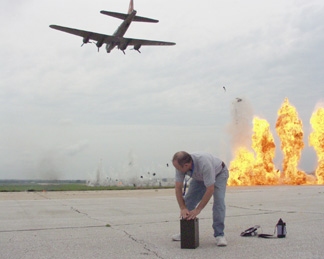When Tom Poulton, M.D., isn’t taking care of critically ill children, spending time with his family or planting flowers in the yard, you might find him playing with fire.
For three days, at the crack of dawn, the UNMC professor of pediatrics, critical care and anesthesiology helped build and detonate pyrotechnics that would add realism to simulated airfield strafing and bomb runs during last month’s Offutt Air Force Base air show.
 |
Tom Poulton, M.D., helped build and detonate pyrotechnics at the Offutt Air Force Base air show in August. |
Although Dr. Poulton has been creating aerial ballet with fireworks for years, this would be his first experience with the TORA! TORA! TORA! Bomb Squad. The Tora group, whose purpose is to entertain and display the history lesson that propelled the United States into World War II, is a national group that recreates the Dec. 7, 1941, attack on Pearl Harbor, as well as provides pyrotechnics at air shows.
Comprised of 140 volunteers from across the country, volunteers work as ground crew, maintenance, pilots and pyrotechnic special effects specialists.
While an estimated 150,000 air show spectators waited, Dr. Poulton and about 15 pyrotechnic specialists, with the smell of jet fuel in the air, put finishing touches on their grid of gas, detonating cord and dynamite they’d choreographed and laid out on the ground.
The beginning of a hobby
Dr. Poulton’s hobby ignited about 12 years ago when his son, Mike, developed an interest in electronics.
“He’s the technical genius,” Dr. Poulton said. “At age 8, he got to a level where I couldn’t answer his questions anymore so I called a guy I knew who did fireworks professionally. I thought the guy would think I was nuts, but then he said he was 8 years old when he started doing fireworks.
“It became a father/son activity,” Dr. Poulton said. “It was fun, and we were doing something for the community.”
This year, father and son hooked up with Tora’s lead pyrotechnic specialist, Bob West of Bellevue.
Dr. Poulton said the pyrotechnics of Tora are similar to doing fireworks. “The commonality is that there is a tremendous amount of work and the performance is over so quickly,” he said.
The difference, said Mike Poulton, is “fireworks are a more artistic display whereas this is brute force, large fireballs and noise, with airplanes flying.”
Recreating history
With safety briefings complete, West gives the command, “Be on your toes.”
The team disperses to its posts.
The “Puff the Magic Dragon” explosion — the first of about six scheduled detonations — would replicate a massive simulated aerial gun attack by a WWII AC-47 attack aircraft, followed by F-16 fighters simulating strafing the airfield with Gatling guns and bombs.
Team members had the best seats in the house, watching airplanes fly directly overhead and take off and land less than 100 yards away.
This is one of the things Dr. Poulton loves about this hobby.
While he waited for his curtain call, Dr. Poulton sat on the tarmac watching a “dogfight” between a World War II-era American P-51 Mustang fighter aircraft and replica Japanese Zero fighter, and a simulation of the WWII Doolittle Raid over Tokyo by a B-25 bomber aircraft. He also saw flying demonstrations by modern aircraft such as the F-117A stealth fighter and B-1 bomber.
“I think this is really fun,” Dr. Poulton said. “That’s why I’m here. It’s pretty impressive to think about what these aircrews did in WWII.”
Chatter from West is again heard over the two-way radio. “Four minutes to ‘puff.’ ”
Minutes later, the team sees the C-47 in the distance. As it approaches the runway, the cue is given and one team detonates the first explosion. The noise, combined with the 100-foot-high tower of flames followed by billowing smoke, is enough to make anyone jump, and gives Tora’s motto some truth: “If you see us running, you better catch up.”
Even at a safe distance, the team feels the warmth of the fireball.
The show’s finale
After more than an hour of pyrotechnics, it’s time for the finale — the “wall of fire.” It’s the “doc’s” turn, as the team now affectionately calls Dr. Poulton.
“Make that hot,” West commands, pointing to the shoebox-size, black detonation box not far in the distance.
Dr. Poulton takes his place, rigs up the wires to the box and is ready for his premier stint. With about 150 yards of detonation material laid, the explosion is expected to be the biggest blast of the day, simulating multiple strafings and bombings with WWII era P-51 and P-47 fighter aircraft and B-17 and B-15 bomber aircraft.
As the aircraft fly over the runway, West gives the signal and Dr. Poulton plunges the handle. The mayhem wows the crowd, and Dr. Poulton turns to admire the clouds of smoke he’s created. A feeling of accomplishment passes and the excitement is over — until the next day of the air show when the team starts all over again.